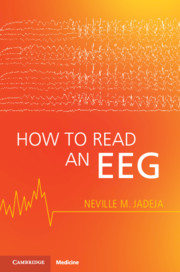Book contents
- How to Read an EEG
- How to Read an EEG
- Copyright page
- Dedication
- Contents
- Figure Contributions
- Foreword
- Preface
- How to Read This Book
- Part I Basics
- Chapter 1 Introduction
- Chapter 2 Polarity
- Chapter 3 Montages
- Chapter 4 Localization
- Chapter 5 Active Reference
- Chapter 6 Frequencies and Rhythms
- Chapter 7 Maturation
- Chapter 8 Normal Adult EEG
- Part II Interpretation
- Part III Specific Conditions
- Appendix How to Write a Report
- Index
- References
Chapter 1 - Introduction
from Part I - Basics
Published online by Cambridge University Press: 24 June 2021
- How to Read an EEG
- How to Read an EEG
- Copyright page
- Dedication
- Contents
- Figure Contributions
- Foreword
- Preface
- How to Read This Book
- Part I Basics
- Chapter 1 Introduction
- Chapter 2 Polarity
- Chapter 3 Montages
- Chapter 4 Localization
- Chapter 5 Active Reference
- Chapter 6 Frequencies and Rhythms
- Chapter 7 Maturation
- Chapter 8 Normal Adult EEG
- Part II Interpretation
- Part III Specific Conditions
- Appendix How to Write a Report
- Index
- References
Summary
EEGs are a simple and commonly used neurological test that most trainees find hard to interpret. Summations of excitatory and inhibitory postsynaptic potentials of pyramidal neurons in the superficial layers of the cortex generate electrographic activity. These occur constantly, hence normal electrographic activity is continuous. Subcortical structures such as the thalamus and reticular activating system (RAS) modulate cortical neuronal activity, resulting in electrographic rhythms. A sizable area of cortex is required to generate enough signal on scalp recordings. Small potentials may be missed. Voltage is current times resistance (Ohm’s law). EEGs are used in a variety of clinical care settings, including clinics, wards, emergency rooms, critical care units, and operating rooms. Like every other test, the EEG has significant technical and practical limitations. EEG electrodes should have low impendences (less than 5 ohms). Electrodes are placed on the scalp using a standardized system (international 10-20 system). EEGs should be calibrated before and after each recording. Each major division is 1 second within which there are five subdivisions of 200 milliseconds each. For adult records, most readers will use a sensitivity of 7 uV/mm, low-frequency filter of 1 Hz, high-frequency filter of 70 Hz, notch filter (60 Hz), and paper speed of 30 mm per second.
Keywords
Information
- Type
- Chapter
- Information
- How to Read an EEG , pp. 1 - 14Publisher: Cambridge University PressPrint publication year: 2021
